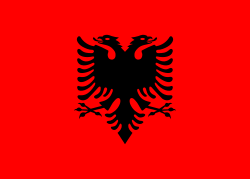| Flag | Date | Use | Description |
|---|
 | 2012–present | Aerodrom Municipality | |
 | ? – Present | Aračinovo Municipality | A red flag with the coat of arms in the middle and two thin horizontal stripes. |
 | ? – Present | Berovo Municipality | A light (sky) blue flag with red insignia in the middle. |
 | 2006–present | Bitola Municipality | A white background with the municipal coat of arms, in the middle. |
 | ? – Present | Bogdanci Municipality | A blue and red flag (two blue & two red cantons), with the Municipality coat-of-arms in the middle. |
 | 1996–present | Bogovinje Municipality | A red background with the municipal coat of arms, in the middle. |
 | 1996–present | Bosilovo Municipality | |
 | | Brvenica Municipality | |
 | 2010–present | Čair Municipality | A white background with the municipal coat of arms, in the middle. |
 | | Čaška Municipality | |
 | ?–2014 | Municipality of Češinovo-Obleševo | |
 | | Centar Župa Municipality | |
 | | Municipality of Čučer-Sandevo | A white background with the municipal coat of arms, in the middle. |
 | | Debar Municipality | |
 | | Debarca Municipality | |
 | | Municipality of Delčevo | |
 | ?–2015 | Demir Hisar Municipality | |
 | | Demir Kapija Municipality | A yellow background with the municipal coat of arms, in the middle. |
 | | Dojran Municipality | |
 | | Dolneni Municipality | |
 | ?-Present | Gevgelija Municipality | A flag with a blue bar over a white bar & the coat-of-arms of the Municipality near the mast of the flag. |
 | | Gostivar Municipality | |
 | 1996–present | Ilinden Municipality | A red vertical flag with a 12-pointed sun and the letter "I" in Cyrillic (И). |
 | | Jegunovce Municipality | |
 | | Karbinci Municipality | A white background with the municipal coat of arms, in the middle. |
 | | Kavadarci Municipality | |
 | ?–2015 | Kisela Voda Municipality | |
 | 2010–present | Municipality of Kočani | |
 | | Konče Municipality | A red background with the municipal coat of arms, in the middle. |
 | 2006–present | Kratovo Municipality | |
 | 2009–present | Kriva Palanka Municipality | |
 | 2005–present | Karpoš Municipality | A yellow background with the municipal coat of arms, in the middle. |
 | | Municipality of Krivogaštani | A red background with the municipal coat of arms, in the middle. |
 | | Municipality of Kruševo | |
 | 2002–Present | Kumanovo Municipality | A red background with the municipal coat of arms, in the middle. |
 | | Lipkovo Municipality | |
 | | Lozovo Municipality | |
 | ?-Present | Makedonska Kamenica Municipality | |
 | | Makedonski Brod Municipality | |
 | | Municipality of Mavrovo and Rostuša | |
 | | Mogila Municipality | |
 | | Negotino Municipality | |
 | | Novaci Municipality | |
 | | Novo Selo Municipality | |
 | | Municipality of Pehčevo | |
 | | Petrovec Municipality | |
 | | Plasnica Municipality |
 | ? – Present | Prilep Municipality | A dark blue background with the municipal coat of arms, outlined in white, in the middle. |
 | 2015–present | Municipality of Probištip | |
 | 2007–present | Rankovce Municipality | |
 | | Resen (municipality) | A white background with the municipal coat of arms, in the middle. |
 | | Rosoman Municipality | |
 | | Skopje Municipality | |
 | | Municipality of Sopište | |
 | | Municipality of Staro Nagoričane | |
 | | Municipality of Štip | A white background with the municipal coat of arms, in the middle. |
 | ?-Present | Struga Municipality | A blue vertical flag with the coat of arms in the middle. |
 | ?-Present | Strumica Municipality | A white vertical flag with the coat of arms and a blue-yellow border. |
 | | Municipality of Studeničani | |
 | ?-Present | Radoviš Municipality | |
 | 2007–present | Tearce Municipality | |
 | ?-Present | Tetovo Municipality | A red, black and yellow tricolor flag, the yellow one being the thickest. |
 | | Valandovo Municipality | |
 | | Vasilevo Municipality | |
 | ?-Present | Veles Municipality | |
 | ?-Present | Vevchani Municipality | |
 | 2007–present | Vinica Municipality | A red and blue bicolor flag with outline of Vinica Fortress and an icon. |
 | | Municipality of Vrapčište | |
 | | Zelenikovo Municipality | |
 | 1996–present | Municipality of Želino | |
 | | Zrnovci Municipality | |
 | | Šuto Orizari Municipality | A white background with the municipal coat of arms, in the middle. |


































































































